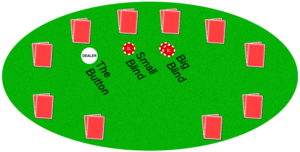 Image via Wikipedia
Image via WikipediaTime and time again, I’ve seen too many players misplay their cards in situations that call for it. And they pay for it; they lose their chip strength or in the worst case, get kicked out of the tournament. Chip management is the single most important skill one must learn in poker. Bluffing pales in comparison to this important skill, and now, I’ll teach you how to manage it well.
Conservative at the Start
Early in the tournament, when the blinds are low and with a good number of weak poker players around, it is important that you stay tight rather than jeopardizing your tournament dream. The antes are low, so there is no rush to be the chip leader. Relax and take it slow, only playing the best-looking hands. Don’t be a rock though, because no one will call your bets when you finally have a hand. In a nutshell, mix up your play but be conservative around 80% of the time.
Faster at the Middle
In the middle of the tournament, where a third or half of the competition is gone, and the tables are becoming smaller, with only five to seven people around, it’s time to speed up your play. From here, you should start putting up continuation bets and eat up small pots. This is important because the blinds are now chasing you and will substantially take a part of your stack if you become the big or small blind. Your poker instincts become more important this time around, because you will have to read your opponents plays if they are retaining their conservative nature or beginning to show some courage.
A Freak at the End
Nothing’s more important in the end-game than your feel for the table and your aggressive technique. You should learn how to play cards like 9-4 and take it to the top. Top players like Doyle Brunson have won the World Series of Poker with cards like 10-2. And in fact, he has done it with the same card twice.
Since this has confused many, I’ll give you an example. If you are dealt 10-4 and at the small blind, just limp in and see if he/she calls. If your opponent puts up a reasonable raise, just call it because you have a high card in 10 and it is unlikely that he/she has an AJ given that there are only two players. Also, there are lesser combinations for the card deck to work with. If the flop shows 2-4-9, bet around half of the pot and it’s likely that your opponent will fold it. That’s the nature of heads-up play. A low pair is equivalent to a high pair in a full table and in my example, getting nines is a premium holding card. Keep that basic rules in mind and you’ll have an idea how play in a short table and more importantly, heads-up.
Conclusion
From what you may have noticed, the style you should follow early in the tournament is a conservative one and as the game marches on, you should adopt a more aggressive approach. That’s why one should be familiar to both styles as it will aid you in tournament play where millions are at stake. Poker’s reach has extended through farther regions of the globe and is gaining popularity in places like The Philippine Islands and in New Zealand. So to speak, a No Limit Hold ‘Em game may be ongoing a few blocks away. If you keep these rules in mind and you may win a tourney in those local casinos one day.
